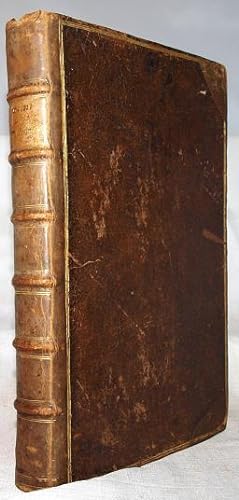VITRUVIUS, M POLLIONIS (3 resultados)
Tipo de artículo
- Todo tipo de artículos
- Libros (3)
- Revistas y publicaciones
- Cómics
- Partituras
- Arte, grabados y pósters
- Fotografías
- Mapas
-
Manuscritos y
coleccionismo de papel
Condición
- Todo
- Nuevos
- Antiguos o usados
Encuadernación
- Todo
- Tapa dura (2)
- Tapa blanda
Más atributos
- Primera edición
- Firmado
- Sobrecubierta
- Con imágenes del vendedor (2)
- Sin impresión bajo demanda
Ubicación del vendedor
Valoración de los vendedores
-
Folio. [8], 30, [2], 252, [2], 253-272, [28], 164, 69, [3] p. Engraved title page, 70 woodcuts in the text illustrating archtectural styles and details. Recent panelled calf binding in period style. The spine with raised bands and the old label re-laid. Internally clean, crisp and well margined. A very good copy.
-
De Architectura Libri Decem. Cum Notis, Castigationibus & Observationibus Guilielmi Philandri Integris; Danielis Barbari Excerptis, & Claudii Salmasii Passim Insertis.omnia in Unum Collecta, Digesta & Illustrata
Publicado por Amsterdam: Ludovicum Elzevirium (Elzevir), 1649
Librería: Sequitur Books, Boonsboro, MD, Estados Unidos de America
Miembro de asociación: IOBA
Libro
Hardcover. Condición: Very Good. 1649. Folio, old gilt-paneled calf, rebacked & repaired with new corners in the 19th century; spine scuffed. With additional engraved vignette title. Illus & figures in text. Scattered light foxing. Complete. 30, [2], 272, [27], 164, 93, [3]pp.Folio. 31 cm. Bound in contemporary full speckled calf leather. Rebacked spine and corners in 19th century leather. Gilt spine. 6 raised bands. Page ends washed red. Marbled end pages. Tight binding and good cover. Owners small bookplate on inside board. Collated and found complete. [6], 30, [2], 272, [28], 164, 69, [3]p : frontis, illustrations. Clean, unmarked pages. BMC XXVI, 301.818; Willems 1097; Fowler 417; Berlin Katalog 1817, Brunet V, 1328. This composite work, a variorum edition, published in 1649 by Johannes de Laet, a professor at the University of Leyden and director of the Dutch East India Company (1581-1649), combines Vitruvius' De architectura with various texts more or less linked to Vitruvius and to architecture. After the dedication to Queen Christina of Sweden, de Laet printed his own Latin translation of the Henry Wotton's 1624 edition of Elements of Architecture. He continued with the edition of Vitruvius published in the enlarged version of 1552 by Jean de Tournes with the Annotationes by Guillaume Philandrier which makes up the majority of the abundant commentary of footnotes. Following that is Georg Bauer's (Agricola) The Epitome from the treatise on weights (De mensuris et ponderibus Romanorum atque Graecorum), written by the same Philandrier. He also relied and used Barbaro's commentary, the Plinianae exercitationes in Caii Julii Solini Polyhistoria (1629) by Claude Saumaise, and the works of the Hellenist and historian Gerardus Joannes Vossius. The book continues with unpublished notes by the mathematician and music historian Marcus Meibom on Vitruvius and his music theory, with an essay, also unpublished, by the mathematician Nicolaus Goldmann on the Ionic volute and with the Greek and Latin indices on De architectura and the Annotationes taken from Philandrier. After that is the 1612 publication, De verborum Vitruvianorum significatione and the Scamilli impares Vitruviani by Bernardino Baldi. At the end there is a passage from chapter 8 of Scamozzi's book VI (L'idea della architettura universale, 1615). And also, added to all these texts presented as the "must read list" of Vitruvian and architectural literature, are Alberti's De pictura, extracts of the De sculptura by Pomponius Gauricus, the commentary by Louis de Montjosieu on the sculpture and painting of the Ancients (Commentarius de sculptura, caelatura, scalptura, et pictura antiquorum, 1602), and finally a brief commentary by Claude Saumaise on two passages by Solin and a general index. Though de Laet, takes up the text of the 1552 edition of De architectura, and split up the books and chapters followed by Philandrier's Annotationes in their enlarged version, de Laet, nevertheless, didn't hesitate to delete a good number of Philandrier's illustrations in his commentary. On the other hand he reproduced with all its woodcuts the Digression on the orders (Digressio utilissima.), consecrating it in that way as a Vitruvian reference par excellence. De Laet's landmark work on Vitruvius, was daunting and slightly haphazard, as noted by Brunet, but the amount of scholarship he produced in one edition, is a measure of the effects of Vitruvius on the Enlightment and Renaissance. F. Lemerle, Les Annotations de Guillaume Philandrier sur le De architectura de Vitruve, 2000, 2011; K. A. Ottenheym, "The Vitruvius edition, 1649, of Johannes de Laet (1581-1649)", LIAS, 25, 1998-2, pp. 217-229.
-
De Architectvra Libri Decem Ad Caesarem Avgvstvm
Publicado por Jean de Tournes, Lyons, 1552
Librería: APPLEDORE BOOKS, ABAA, WACCABUC, NY, Estados Unidos de America
Full leather. Condición: Very Good. Bernard Salomon Ilustrador. Edited by Guillaume Philander. Lyons: Jean de Tournes, 1552. De Tournes's device on title, 83 woodcuts, one folding plate of a monumental inscription, head-pieces, initials, a second printer's device on verso of last leaf. First de Tournes edition of Vitruvius with the revised and expanded commentary and notes by Philander (1505-1563) and illustrations by Bernard Salomon. Philander studied with Serlio in Venice and worked on Vitruvius in Rome in the Accademia delle Virtú. "Philander's work is at once a learned study and a practical manuel of architecture, incorporating the methods of both the humanists and architects. It is the first synthesis of academic and practical interpretations of Virtruvius' treatise to appear in published form" (Millard). In solid, very presentable condition. The spine re-backed in an early 20th century light-calf over dark, blindstamped, 17th century boards.




